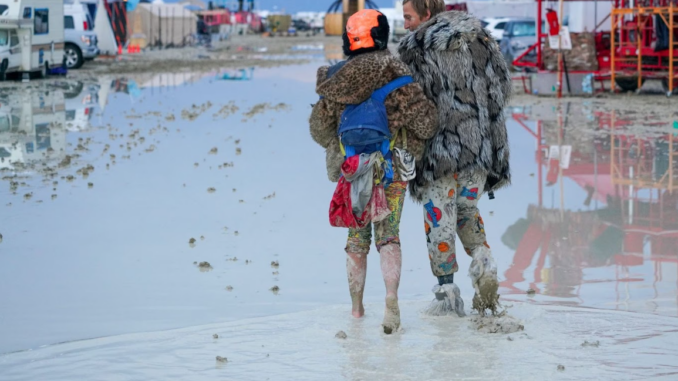
By Kate Dempsey
Picture this: you’ve spent $485 on a ticket to attend a once-in-a-lifetime experience in the heart of the Black Rock Desert, the Burning Man Music Festival. You must provide your own amenities (hope you brought enough to eat!). It’s a festival that projects a countercultural image, an anarchy that is based on “radical” social acceptance. You expect to have a weekend full of fun and a journey of self-discovery, but instead, you suffer from hypothermia, are covered to the waist in sludge, and are unable to leave due to a horrific storm. Sounds like fun, right?
If we’d have learned anything from 2023 thus far, we would have realized that anything spear-headed by rich white people only serves their own interests (looking at you, Titan submersible). Burning Man has always been a festival of neglect: neglect of the environment, neglect of social consciousness, and neglect of its own festivalgoers.
One of their principles is “leave no trace,” yet every year, they leave behind mountains of trash. And every year, their fire displays produce enough carbon dioxide that no amount of tree planting could offset. Hopefully, trudging through the sludge will also be a wakeup call for climate change for some of the attendants, seeing as they don’t respect the space Mother Nature has given them.
They cosplay as survivalists, ignoring that for many in the United States they struggle just to put a meal on the table. For example, many white women style their hair as dreadlocks, directly appropriating a hairstyle from people of color. Many people of color wear this hairstyle to celebrate their culture and heritage, and may face discrimination through microaggressions if they do so. When white women do it, they just think “it’s cute,” all the while they are appropriating someone else’s truth. To say that they’re tone-deaf would be an understatement.
Burning Man may seem to be the epitome of how not to conduct a music festival (even after the Fyre Festival catastrophe), but no, because now we have Electric Zoo here on the East Coast. The three-day festival was held on Randall’s Island beginning on Sept. 1, and on opening day, the festival had to be canceled due to their inability to build stages in time. Therefore, festivalgoers were given refunds. Then, day two started two hours late. On the last day of the festival, they claimed to have reached “full capacity,” and subsequently refused to let anyone else in, even if they paid to attend. What ensued was crowds storming the gates and causing a stampede, turning it into a literal zoo.
I will say this as an EDM-lover and DJ: these music festivals do not represent us. It’s true that EDM itself has always had its roots in counterculture; starting from the rave scenes in the 80s and 90s, DJ’s played at warehouses because they were one of the only avenues to do so. It became especially important for those in the LGBTQ+ community at a time when they were not accepted in society, and for musicians of color to have a chance to play their music in an industry that still favored white musicians.
These music festivals represent an overcommercialization of EDM, capitalists getting their hands on this community to make profit. This past summer, The Vanguard’s Editor-in-Chief Serin and I had the privilege of attending Governors Ball Music Festival held at Flushing Meadows Corona Park as part of the media crew. While not strictly an EDM festival, it nonetheless showed what a good execution of a festival should be. They gave back to local communities through donations, and had tents raising awareness for various causes. Safety and accessibility were great. They cared about their festivalgoers.
For music festival lovers or dedicated EDM fans, I recommend supporting local artists and venues instead of giving your money to the co-option of a vibrant music scene. Let’s keep the focus on the music and the happiness it brings, not on image and profit.
